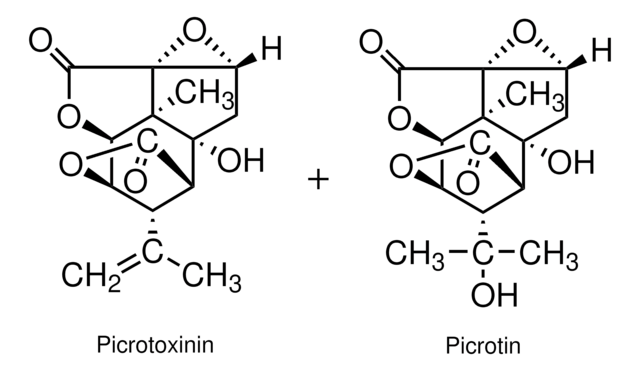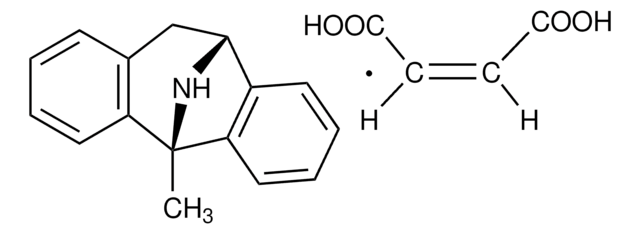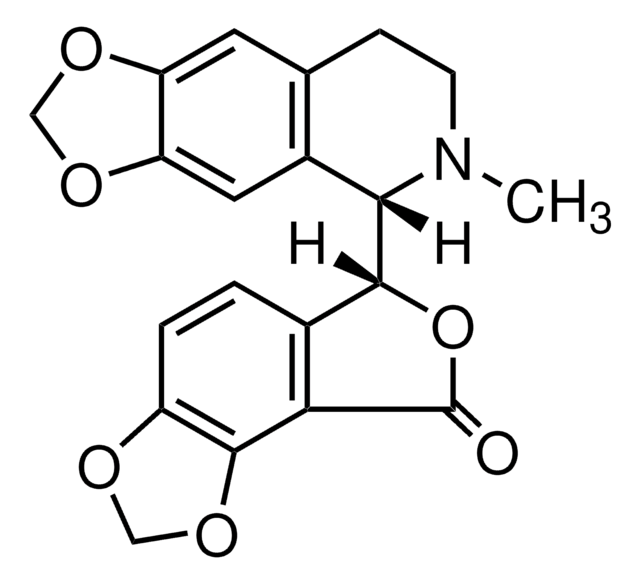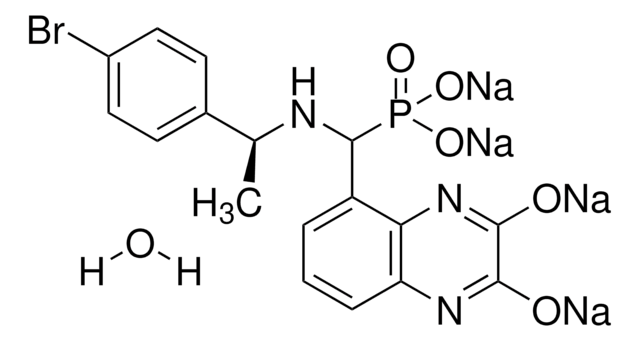N183
NBQX disodium salt hydrate
≥98% (HPLC), lyophilized powder, neuroprotective AMPA/kainate glutamate receptor antagonist
Sinónimos:
1,2,3,4-Tetrahydro-6-nitro-2,3-dioxo-benzo[f]quinoxaline-7-sulfonamide disodium salt hydrate, FG 9202 disodium salt hydrate
About This Item
Productos recomendados
product name
NBQX disodium salt hydrate, ≥98% (HPLC)
Quality Level
assay
≥98% (HPLC)
form
lyophilized powder
storage condition
desiccated
color
, brown to dark red-brown
solubility
H2O: >10 mg/mL
storage temp.
2-8°C
SMILES string
O.[Na+].[Na+].NS(=O)(=O)c1cccc2c1c(cc3nc([O-])c([O-])nc23)[N+]([O-])=O
InChI
1S/C12H8N4O6S.2Na.H2O/c13-23(21,22)8-3-1-2-5-9(8)7(16(19)20)4-6-10(5)15-12(18)11(17)14-6;;;/h1-4H,(H,14,17)(H,15,18)(H2,13,21,22);;;1H2/q;2*+1;/p-2
InChI key
LQSCHRKYVVVUFA-UHFFFAOYSA-L
Gene Information
human ... GRIA1(2890) , GRIA2(2891) , GRIA3(2892) , GRIA4(2893) , GRIK1(2897) , GRIK2(2898) , GRIK3(2899) , GRIK4(2900) , GRIK5(2901)
Application
- in N-methyl-D-aspartate receptor (NMDAR) kinetic studies
- as an α-amino-3-hydroxy-5-methyl-4-isoxazolepropionic acid (AMPA) receptor antagonist for the electrophysiological studies cultured neurons
- in the extracellular solution for current/voltage (I/V) relationship and rectification index experiments in excitatory postsynaptic currents (EPSCs) mediated by NMDA receptors (EPSCNMDAR)
Biochem/physiol Actions
Features and Benefits
signalword
Warning
hcodes
Hazard Classifications
Eye Irrit. 2 - Skin Irrit. 2 - STOT SE 3
target_organs
Respiratory system
Storage Class
11 - Combustible Solids
wgk_germany
WGK 3
flash_point_f
Not applicable
flash_point_c
Not applicable
ppe
dust mask type N95 (US), Eyeshields, Gloves
Certificados de análisis (COA)
Busque Certificados de análisis (COA) introduciendo el número de lote del producto. Los números de lote se encuentran en la etiqueta del producto después de las palabras «Lot» o «Batch»
¿Ya tiene este producto?
Encuentre la documentación para los productos que ha comprado recientemente en la Biblioteca de documentos.
Los clientes también vieron
Contenido relacionado
DISCOVER Bioactive Small Molecules for Neuroscience
Nuestro equipo de científicos tiene experiencia en todas las áreas de investigación: Ciencias de la vida, Ciencia de los materiales, Síntesis química, Cromatografía, Analítica y muchas otras.
Póngase en contacto con el Servicio técnico











